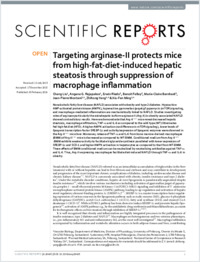Targeting arginase-II protects mice from high-fat-diet-induced hepatic steatosis through suppression of macrophage inflammation
- Liu, Chang Vascular Biology, Department of Medicine, Division of Physiology, University of Fribourg, Switzerland
- Rajapakse, Angana G. Vascular Biology, Department of Medicine, Division of Physiology, University of Fribourg, Switzerland
- Riedo, Erwin Laboratory HFR, Hospital Fribourgeois, Switzerland
- Fellay, Benoit Laboratory HFR, Hospital Fribourgeois, Switzerland
- Bernhard, Marie-Claire Promed Medical Laboratory SA, Fribourg, Switzerland
- Montani, Jean-Pierre Vascular Biology, Department of Medicine, Division of Physiology, University of Fribourg, Switzerland - National Center of Competence in Research “Kidney.CH”, Switzerland
- Yang, Zhihong Vascular Biology, Department of Medicine, Division of Physiology, University of Fribourg, Switzerland - National Center of Competence in Research “Kidney.CH”, Switzerland
- Ming, Xiu-Fen Vascular Biology, Department of Medicine, Division of Physiology, University of Fribourg, Switzerland - National Center of Competence in Research “Kidney.CH”, Switzerland
-
05.02.2016
Published in:
- Scientific Reports. - 2016, vol. 6, p. 20405
English
Nonalcoholic fatty liver disease (NAFLD) associates with obesity and type 2 diabetes. Hypoactive AMP-activated protein kinase (AMPK), hyperactive mammalian target of rapamycin (mTOR) signaling, and macrophage-mediated inflammation are mechanistically linked to NAFLD. Studies investigating roles of arginase particularly the extrahepatic isoform arginase-II (Arg-II) in obesity-associated NAFLD showed contradictory results. Here we demonstrate that Arg-II−/− mice reveal decreased hepatic steatosis, macrophage infiltration, TNF-α and IL-6 as compared to the wild type (WT) littermates fed high fat diet (HFD). A higher AMPK activation (no difference in mTOR signaling), lower levels of lipogenic transcription factor SREBP-1c and activity/expression of lipogenic enzymes were observed in the Arg-II−/− mice liver. Moreover, release of TNF-α and IL-6 from bone marrow-derived macrophages (BMM) of Arg-II−/− mice is decreased as compared to WT-BMM. Conditioned medium from Arg-II−/−-BMM exhibits weaker activity to facilitate triglyceride synthesis paralleled with lower expression of SREBP-1c and SCD-1 and higher AMPK activation in hepatocytes as compared to that from WT-BMM. These effects of BMM conditioned medium can be neutralized by neutralizing antibodies against TNF-α and IL-6. Thus, Arg-II-expressing macrophages facilitate diet-induced NAFLD through TNF-α and IL-6 in obesity.
- Faculty
- Faculté des sciences et de médecine
- Department
- Département de Médecine
- Language
-
- English
- Classification
- Biological sciences
- License
-
License undefined
- Identifiers
-
- RERO DOC 258967
- DOI 10.1038/srep20405
- Persistent URL
- https://folia.unifr.ch/unifr/documents/304846
Statistics
Document views: 131
File downloads:
- pdf: 202
